Are fossil fuels dead? A look at the rising use of natural gas in North America
Posted by Jason Runge on September 10, 2014
As the Earth’s climate continues to rise, governments around the world have introduced policies to reduce both their greenhouse gas emissions and dependency on fossil fuels. But although renewable energy sources have begun to play a larger role in meeting the planet’s ever-increasing energy needs, their widespread use is not feasible in the short-term and questionable in the long term.
The graph below is a breakdown by the U.S. Energy Information Agency (EIA) for the energy consumption within the United States for approximately the last 300 years[1]. It shows that fossil fuels have provided the majority of the country’s energy needs. It would require vast amounts of capital to introduce the infrastructure necessary for renewable energy sources, or nuclear, to provide the same amount of energy that is supplied by fossil fuels.
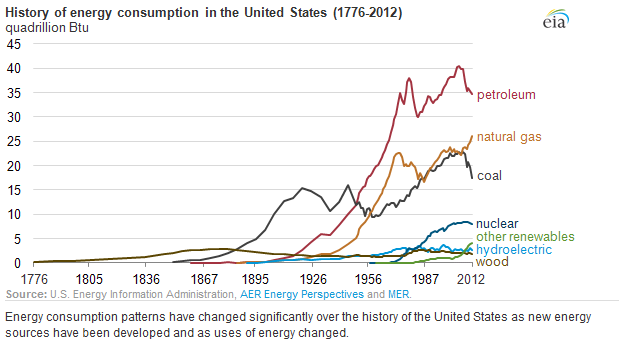
Coal, natural gas and oil are the most well-known types of fossil fuels. Of the three, the burning of natural gas produces the least greenhouse gas emissions[2]. Natural gas is a popular choice for electricity generation because of its reduced cost, quick construction and lower emissions compared to other conventional fossil fuels.
Since 1980, the consumption of natural gas has been fairly consistent in North America and grown increasingly in the Middle East and Asia, according to the EIA table below[3].
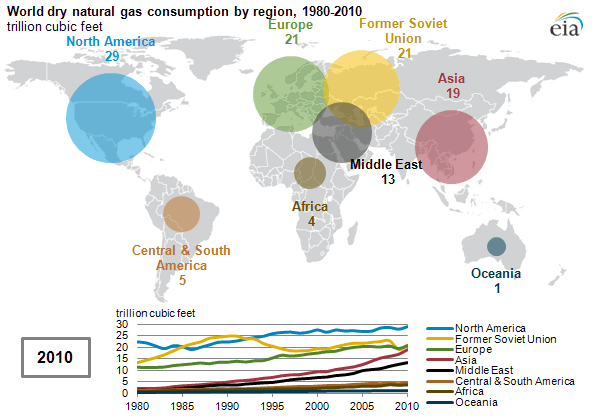
In Canada, twenty two per cent of the country’s energy needs are met by natural gas. According to the EIA, despite holding a relatively small share of the world's proven natural gas reserves, Canada ranks third in dry natural gas production. It is the fourth-largest exporter of natural gas, behind Russia, Norway, and Qatar. Though Canada has plans to export liquefied natural gas (LNG), all of Canada's current natural gas exports are sent to U.S. markets via pipeline. The proportion of Canada's natural gas production that is devoted to meeting domestic requirements has risen in recent years, while net exports to the United States have fallen[4].
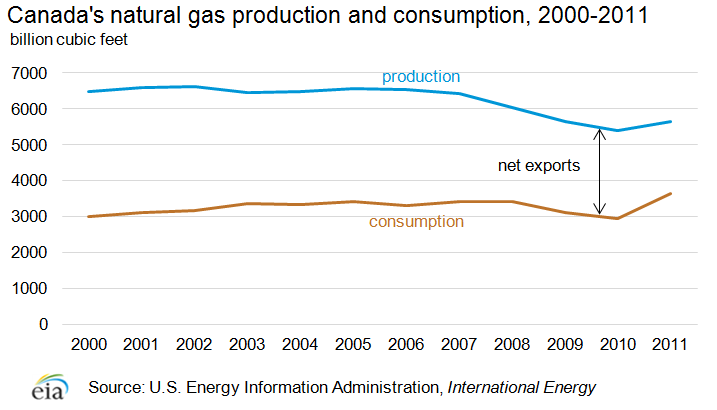
The United States also relies on quite a bit on Natural Gas, both local and imported, and a breakdown of all the natural gas consumption within the United States can be seen below.
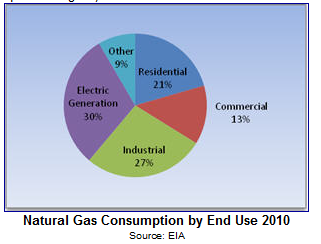
The chart shows that the majority of natural gas in the United States is used for electrical generation, followed closely by industrial and then residential. The EIA predicts that the industrial demand will increase at an average rate of 0.9 per cent per year and the demand for electricity is expected to increase by an average rate of 1 per cent per year until 2035[5]. This information indicates that in the long term, the use of natural gas may become more prominent.
Mexico is a country with an abundance of fossil fuel resources, mainly petroleum, and is one of the top ten oil producing countries in the world. Ninety per cent of the country’s energy needs are met by fossil fuels and natural gas accounts for 29 per cent of its fossil fuels consumption. However, although Mexico consumes a fair amount of natural gas, it is not quite as much as other North American countries. The graph below shows Mexico’s consumption of natural gas exceeds its own production and that the country’s consumption rate has been increasing every year for the last decade and is expected to continue to rise in the future[6].
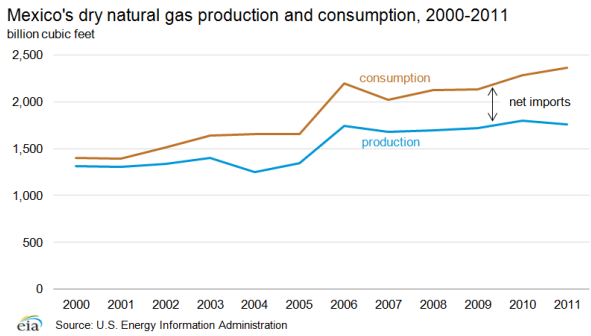
Despite our best intentions to decrease our dependency on fossil fuels, this data demonstrates that the use of natural gas is consistently increasing throughout North America. It is a relatively low-cost, low-emission energy source that could have a myriad of applications in a wide range of sectors.
[1] U.S. Energy Information Administration, "Today in Energy: History of energy consumption in the Unites States," U.S. Energy Information Administration, 9 February 2011. [Online]. Available: http://www.eia.gov/todayinenergy/detail.cfm?id=10.
[2] U.S. Environmental Protection Agency, “Natural Gas”. Available: http://www.epa.gov/cleanenergy/energy-and-you/affect/natural-gas.html.
[3] U.S. Energy Information Administration, "Today in Energy," [Online]. Available: http://www.eia.gov/todayinenergy/detail.cfm?id=5810.
[4] U.S. Energy Information Administration, "Canada," U.S. Energy Information Administration, 17 September 2012. [Online]. Available: http://www.eia.gov/countries/cab.cfm?fips=CA.
[5] U.S Energy Information Administration, "United States," U.S Energy Information Administration, [Online]. Available: http://www.eia.gov/state/seds/data.cfm?incfile=/state/seds/sep_sum/html/sum_btu_1.html&sid=US.
[6] U.S. Energy Information Administration, "Mexico," U.S. Energy Information Administration, 17 October 2012. [Online]. Available: http://www.eia.gov/countries/cab.cfm?fips=MX.
Edited from original submission.
Filed under: Students on Sustainability